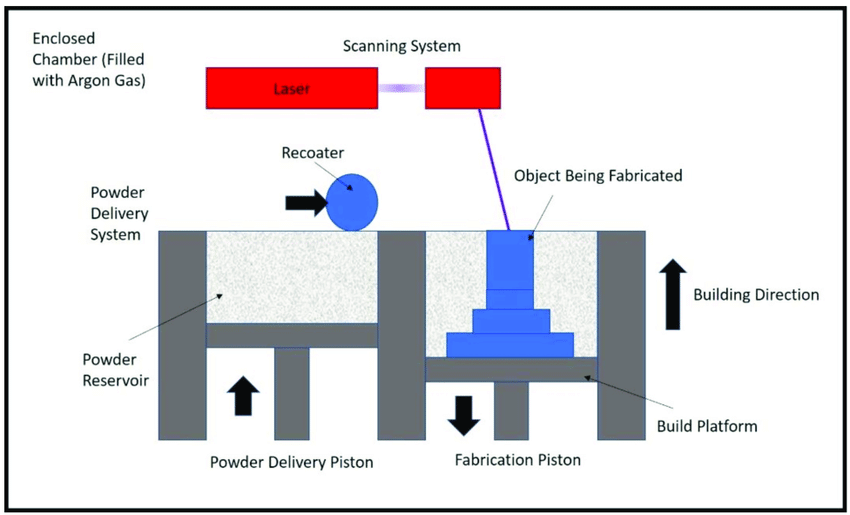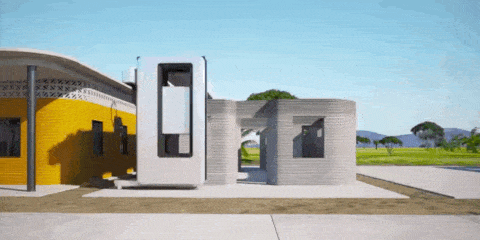While there are many varieties in 3D printer technologies, there are seven most common types. All printing technologies build parts in discrete slices called layers.
- Fused Filament Fabrication (FFF, also known as Fused Deposition Modeling)
- Continuous Filament Fabrication (CFF)
- Atomic Diffusion Additive Manufacturing (ADAM, also known as Bound Powder Deposition)
- Selective Laser Sintering/Melting (SLS/SLM, also known as DMLS for metal)
- Direct Light Processing (DLP)
- Stereolithography (SLA)
- Binder Jetting
Extrusion
FFF (Fused Filament Fabrication)
Much like traditional printers use a variety of technologies. The most commonly known is fused filament fabrication (FFF), also known as fused deposition modeling (FDM). most machines utilize this technology. In FFF, the printer heats up thermoplastic to near melting point. In a filament, composed of acrylonitrile butadiene styrene (ABS), polylactic acid (PLA), or another thermoplastic is melted and extruded it out a nozzle that traces the cross section of a part for each layer.This process repeats for each layer. The first 3D printers to come to market, made in the mid 1990s

CFF (Continuous Filament Fabrication)
CFF is an augmented FFF process that works in addition to an FFF printer to lay continuous fiber in a part. In this process, a printer utilizes a second nozzle to lay continuous strands of composite fibers inside a convention FFF thermoplastic parts. Parts built with the CFF/FFF process are strong and stiff due to their reinforcing fibers.

ADAM (Atomic Diffusion Additive Manufacturing)
ADAM, or bound powder deposition, is a process virtually identical to FFF used to print metal. ADAM uses a filament comprised of metal powder and plastic binder — after printing, the binder is dissolved away and the metal powder is sintered into a full metal part.

Laser Fusion
Laser fusion printers use high powered lasers to fuse powdered media together. This base technology can be used for plastic (SLS) and metal (SLM/DMLS). These machines are usually industrial in nature, as both high powered lasers and powders are difficult to handle. They make precise, strong parts in a wide variety of materials from plastics to metals.
SLS (Selective Laser Sintering)
SLS yields incredibly precise plastic parts. In this process, a printer lays down an smooth layer of powder and then precisely sinters a layer, repeating the deposition and sintering process until the part is complete.
Selective laser sintering (SLS) uses a high-powered laser to fuse particles of plastic, metal, ceramic, or glass. At the end of the job, the remaining material is recycled. Electron beam melting (EBM) uses—you guessed it—an electron beam to melt metal powder, layer by layer. Titanium is often used with EBM to synthesize medical implants, as well as aircraft parts.

SLS/DMLS (Selective Laser Melting / Direct Metal Laser Sintering)
SLM and DMLS utilize the same process as SLS, but use metal powders. Due to metal’s higher melting point and the added risks of metal powder, these machines require higher power lasers and better enclosures.

Light Curing
Light curing creates precise parts in a typically small form factor. Parts made from these processes all must be photopolymers. Light curing is typically used for small prototypes or precise end use parts.
SLA (Stereolithography)
SLA printers can quickly and affordably produce precise parts. They utilize a laser to selectively cure a layer of resin, which is then pulled up and reset for the next layer. Typically, these parts are “pulled” upward out of the resin as they’re built.

DLP (Direct Light Processing)
In a variation on that, you also have digital light projector (DLP) 3D printing. This method exposes a liquid polymer to light from a digital light processing projector. This hardens the polymer layer by layer until the object is built, and the remaining liquid polymer is drained off.
DLP can be used to quickly fabricate photopolymer parts. These printers work in the same way as SLA, but replace the actuated laser with a projector that can cure an entire layer at once.

Powder Adhesion
Powder adhesion is a rapidly growing field in 3D printing that can be used to fabricate both plastic and metal parts. Because the process yields batch parts very quickly.
Binder Jetting
Binder jetting is a cost effective, low-energy method of fabricating parts out of powder. In this process, a machine uses the same powder spreading methods as SLS, but a liquid binding agent is used to adhere parts instead of a laser. After printing, these parts need to be cured (plastic) or sintered (metal) to yield a full part.

credits:
3ds.com
wikipedia.org
markforged.com
pick3dprinter.com



